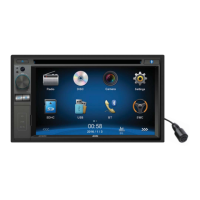Steering Wheel Control - Questions
If this unit is only compatible with anaologue SWC systems, how do I tell if the vehicle has
an analogue or digital system?
Test 1 - Without the radio SWC wires connected.
With an Ohm meter, probe the SWC positive and SWC negative connection on the vehicle. Press
and hold a button on the steering wheel. If the resistance reading changes from an open circuit to
a steady resistance reading, the SWC system is analogue. If however the reading changes from
an open circuit to a pulsing or constantly changing reading while the button is held down firmly,
the SWC system is digital. If your vehicle has more than one SWC positive connection, only half of
the buttons on the steering wheel will be connected to each wire, in which case, you may have to
try a few different buttons before you get a reading.
OR
Test 2 - With the radio SWC wires connected.
With a volt meter, probe the SWC positive and SWC negative connection, while the radio is on.
Press and hold a button on the steering wheel. If the voltage reading drops from 5 volts to a lower
voltage and remains at that voltage as long as the button is held down, the SWC system is analogue.
If the voltage reading starts jumping up and down while the button is held down firmly, the SWC
system is digital. If your vehicle has more than one SWC positive connection, only half of the buttons
on the steering wheel will be connected to each wire, in which case, you may have to try a few
different buttons before you get a reading.
What can I do if the vehicle has a digital SWC system?
A CANBUS SWC adaptor will be required to convert the digital signals to analogue signals.
What if the vehicle does not have any SWC functions or the SWC function is not needed?
Insulate the Key wires.
The SWC wires are connected, but when a button is pushed during the programming
procedure, there is no response from the radio screen.
The resitance of the corresponding resistor in the steering wheel is likely too high to be detected.
Key A can detect higher resistance values than Key B, try swapping Key A and Key B around and
try again. If the radio is still not detecting the button, disconnect the key wires. With an Ohm
meter, probe the posistive and negative SWC connections on the vehicle. If the resistance is
greater than 112.8K, the SWC resistor in the steering wheel will need to be replaced with a lower
value resistor. If there is no reading, try probing the other positive SWC connection on the vehicle
instead. If all connections have been probed and there is still no reading when the button is pushed,
then there is a fault in the vehicle wiring. Locate and rectify the fault. If there is a resistance reading
while no buttons are being pressed, there is a fault in the vehicle wiring. Locate and rectify
the fault.
All of the SWC buttons were successfully programmed, but 1 or more of the buttons do
not work.
If 2 or more of the resistors in the steering wheel have resistance values that are too close to one
another, the radio may register the different buttons as the same button, overwriting 1 or more of
the programmed functions. Key B is more sensitive to differences in resistance, try swapping
around the key wires and reprogram the functions. If the radio is still unable to distinguish 2 or
more buttons, the resistors in the steering wheel will need to be changed to more distinct values.
25.

